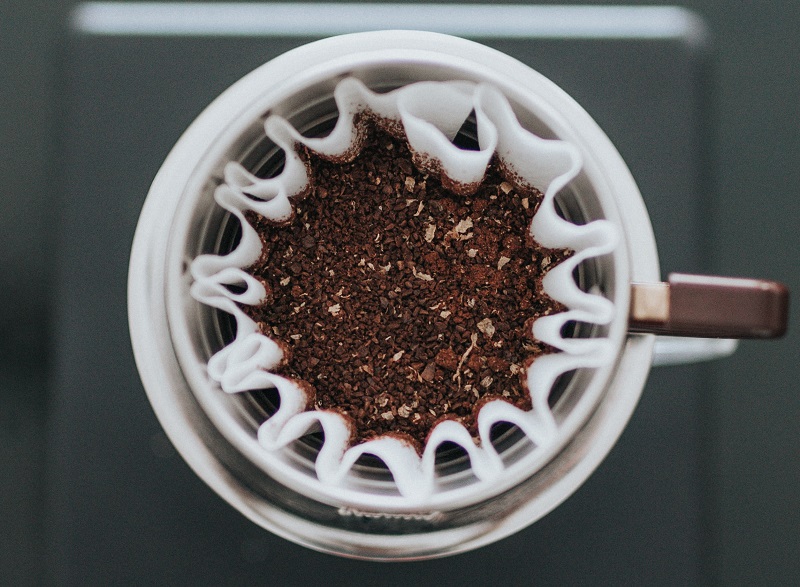
Brewing coffee at home is a daily ritual for 79% of Americans.1 Are you one of them? If so, you might not have thought about what’s happening to those coffee filters piling up in your trash can. Using your coffeemaker at home can save you time on your way to work and spare the earth the consequences of disposable cups, but it is important to think about how eco-friendly your morning ritual really is.
We’re here to round up the facts and set things straight when it comes to the most sustainable way to brew your favorite cup.

Disposing of Your Filters
The real issue when it comes to paper filters is how to dispose of them safely. Since coffee drinkers generate so many of them daily, they can clog up landfills and aren’t acceptable for recycling because of the oils from the coffee.
If you’re a gardener, you probably understand that composting with coffee grounds is easy, eco-friendly, and can add nitrogen to your compost heap.
The good news: your paper filters can go straight into the compost with the grounds! Keeping them moist is best, and you can tear or cut them up if you want them to compost faster. It’s also a good idea to spread them out in your compost and mix them with other items because it will help them break down more quickly, and they can produce a strong odor when they’re piled together.
It can take six to eight months for a wet coffee filter to degrade. This might sound like a long time, but it’s a lot faster than throwing your filters in the garbage.
Composting is an excellent option if you want to stick with your convenient, easy-to-clean paper filters. If you don’t have your garden, ask your friends or in a local Facebook group—you might find someone who wants to take your grounds and filters off your hands.

Bleached vs. Unbleached: Which is Better?
You’ve probably seen two different paper filters in the coffee aisle: bleached (white) and unbleached (brown). What’s the difference, and which is suitable for the environment?
Brown is the natural color of paper, which means that the white paper filters are treated using bleaching agents, including chlorine. The coating that turns it white also makes it more difficult to compost.
Unbleached filters, however, are untreated and therefore ideal for composting, making them the more sustainable choice.

Creative Ways to Repurpose Used Filters
If you want to get the most out of your paper filters before you compost them, there are a number of ways you can put them to good use. You’ll have to clean them and dry them out first, but a little extra work will give you the satisfaction of knowing that your filters didn’t go to waste.
You can always reuse your filters for their original purpose: making a cup of coffee. There’s no official number of times you can use the same filter before it affects the taste. It’s different strokes for different folks, so experiment with how many times you use the same one before sending it to the compost heap.
If you have a green thumb, you can use your paper filters either as liners for your planters or to germinate seeds—talk about doing double duty!
They’re also a helpful household product that is suitable for straining grease from fatty foods, substituting for paper towels when wiping down surfaces, and neutralizing odors.
You could even try out a new arts and crafts project utilizing your old paper filters. Your creativity is the limit!

Switching to a Reusable Filter
If you’d rather not deal with composting, don’t worry—there are alternatives. You can opt-out of paper filters altogether and purchase a reusable filter instead.
As with everything in coffee culture, there’s an endless variety of reusable filters for you to choose from. Stainless steel, cloth, plastic—it all depends on how you make your coffee and what you want out of your filter.
You do need to wash the filter after every use, which brings up the question of water conservation when we’re talking about sustainability. It turns out that the water it takes to clean a reusable filter is negligible, though the amount it takes to produce one cup of coffee numbers is a staggering 35 gallons.
So, if you’re on a quest for coffee sustainability, you may need to think about how you source your beans as well considering the best filter option for you can be a great start.

Conclusion
Are coffee filters bad for the environment? Yes and no. Sending them to the landfill without thinking about the consequences can have a negative impact on the environment, but there are plenty of easy solutions to mitigate that impact.
If you’re responsible, thoughtful, and creative when disposing of or reusing your paper filters, they can be a convenient and eco-friendly choice. That way, you can enjoy your coffee knowing you’ve done your part to brew your most sustainable cup.
- https://foodprint.org/blog/environmental-impact-coffee-cup/
- https://disturbmenot.co/coffee-statistics/
- https://www.thinkingsustainably.com/are-coffee-filters-compostable/#3–bleached-vs-unbleached-filters-
- https://www.alliancecoffee.net/how-to-reduce-the-environmental-impact-of-paper-filter/
- https://www.gardeningknowhow.com/composting/ingredients/coffee-grounds-gardening.htm
- https://www.bustle.com/life/best-reusable-coffee-filters
- https://www.sierraclub.org/sierra/ask-mr-green/are-reusable-coffee-filters-or-paper-filters-good-for-environment
- https://pela.earth/blogs/news/can-you-compost-coffee-filters
- http://www.sweetpeasandpumpkins.com/2013/03/starting-seeds-using-coffee-filter.html
- https://coffeeaffection.com/can-you-reuse-coffee-filters/#:~:text=Reusing%20Paper%20Filters%20to%20Brew%20Multiple%20Batches%20of%20Coffee&text=Once%20the%20filter%20is%20dry,and%20using%20a%20new%20one
- https://kidsactivitiesblog.com/49632/coffee-filter-crafts/
Featured Image Credit: MLARANDA, Pixabay














